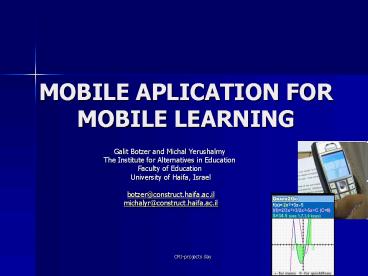MOBILE APLICATION FOR MOBILE LEARNING - PowerPoint PPT Presentation
1 / 10
Title:
MOBILE APLICATION FOR MOBILE LEARNING
Description:
... the opposite of virtual reality (VR), where virtual reality puts people inside ... to construct graphs showing the boy and the girl walking and sent Amman via SMS ... – PowerPoint PPT presentation
Number of Views:28
Avg rating:3.0/5.0
Title: MOBILE APLICATION FOR MOBILE LEARNING
1
MOBILE APLICATION FOR MOBILE LEARNING
- Galit Botzer and Michal Yerushalmy
- The Institute for Alternatives in Education
- Faculty of Education
- University of Haifa, Israel
- botzer_at_construct.haifa.ac.il
- michalyr_at_construct.haifa.ac.il
2
Math4Mobile project
- Development and research of mathematical
applications for cellular phones - Developers
- Michal Yerushalmy
- Arik Weizman (software and site), Zohar Shavit
(software), department of computer science
3
IT and Technology in Math Ed
math4mobile
First wave
Second wave
Third wave
4
The 3rd Wave Ubiquitous Computing
- Ubiquitous is being everywhere, omnipresent
- Alan C. KeyInvisible computing meant to be
working in the background of human beings and
supporting their lives. It is sometimes described
as calm and human technology.
5
Invisible computing
- Arun Kumar Tripathi in
- Reflections on Challenges to the Goal of
Invisible Computing http//www.acm.org/ubiquity - Ubiquitous Computing is roughly the opposite of
virtual reality (VR), where virtual reality puts
people inside a computer-generated three
dimensional world. - Ubiquitous computing forces the computer to live
out here in the world, make connections with
people.
6
Learning with mobile devices
- Socio-cultural aspects
- Mobile technology has the potential of improving
classroom dynamics owing to their computation and
communication capabilities, which augment
face-to-face interactions - Supporting collaborative learning scenarios and
the creation of a community in which learners
can work together, share knowledge, inspire each
other, and interact socially - Learning in context
- Embedding the learner in a realistic context at
the same time as offering access to supporting
tools can enhance the active construction of
personal knowledge
7
Using mobile devices to enhance mathematics
learning
- Enhancing mathematics learning by providing a
11 student device ratio and by enabling
ready-at-hand access to technology throughout the
school day and the learners personal life.
- Roschelle, Patton and Tatar 2007
8
Design consideration for Learning with mobile
phones
- Turning the dangerous tool into a constructive
one The idea of putting the damn cell phones to
some good use is absolutely brilliant - Unique features rather than replicating PC
features - Personal communication connectivity,
collaboration, sharing work applications via
sms - Personal use small screen, handy, limited
keyboard - Exploiting the availability of cellular
accessories such as cameras to enhance the
learners engagement with mathematics learning.
9
The Math4Mobile application
Sketch2Go encourages visual exploration of
phenomena (e.g., physical temporal phenomena) by
providing qualitative indication of the ways in
which the sketch drawn by the user changes. The
sketch motivates learners to experiment with a
given situation, analyze it, and reflect upon it.
Graph2Go a special-purpose graphing calculator
that operates for given sets of function
expressions. Its unique feature is enabling the
dynamic transformation of functions.
10
The pilot case study
- Participants two pairs of mathematics major
students studying for a teaching certificate. - The course Mathematics methods course, which
was focused on collaborative project activities
supported by technological tools. - The technology Students were equipped with the
necessary mobile phones - The learning setting included face-to face
activities and mobile activities alternately. - Data collection Face-to-face activities were
videotaped, participants kept personal diaries to
document their work and summarizing interview was
conducted.
11
A mobile learning scenario
a
b
Amman approved that the graph where correct and
sketched the graphs in her diary
12
A mobile learning scenario- (Continued)
Ziva sent her colleagues SMS and asked them to
review their graph
13
Aspects of mobile learning
- The active engagement in the modeling of real
world phenomena can be attributed to three main
aspects - The mobility of the learning environment
- Communication capabilities of cellular devices
- Handy and easy to use applications
14
Conclusion
- We found that the contribution of the mobile
environment lies not only in making dynamic
mathematical application more available, but also
in supporting the execution of mathematical tasks
that are closer to the students experiences and
more relevant to them and supporting the creation
of community of learners - Further challenges
- Didactical challenge how the instructor can
guide students during mobile learning activities?
- Methodological challenge how researchers can
fully document learning processes in mobile
learning setting?
15
Acknowledgments
- The support of Eurocom Israel for this Study is
Gratefully acknowledged































